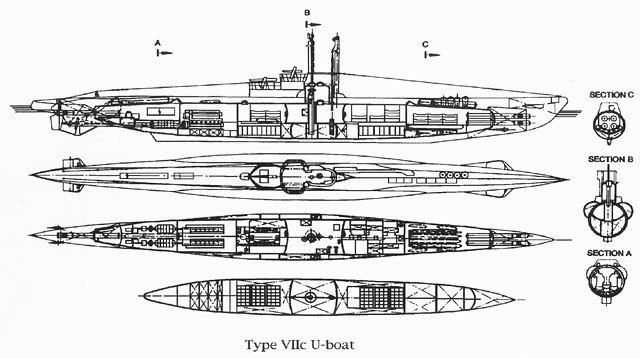Name U-293 Yard number 58 Commissioned 8 September 1943 Launched 30 July 1943 Draft 4.74 m | Ordered 14 October 1941 Laid down 17 November 1942 Construction started 17 November 1942 Length 67 m Beam 6.2 m | |
 | ||
Part of | ||
German submarine U-293 was a Type VIIC/41 U-boat of Nazi Germany's Kriegsmarine during World War II. She was laid down on 17 November 1942 by the Bremer Vulkan Werft (yard) at Bremen-Vegesack as yard number 58, launched on 30 July 1943, and commissioned on 8 September with Kapitänleutnant Leonhard Klingspor in command. In six patrols, she damaged one warship. She surrendered at Loch Eriboll in Scotland in May 1945 and was sunk as part of Operation Deadlight in December 1945.
Contents
Design
German Type VIIC/41 submarines were preceded by the shorter Type VIIB submarines. U-293 had a displacement of 759 tonnes (747 long tons) when at the surface and 860 tonnes (850 long tons) while submerged. She had a total length of 67.10 m (220 ft 2 in), a pressure hull length of 50.50 m (165 ft 8 in), a beam of 6.20 m (20 ft 4 in), a height of 9.60 m (31 ft 6 in), and a draught of 4.74 m (15 ft 7 in). The submarine was powered by two Germaniawerft F46 four-stroke, six-cylinder supercharged diesel engines producing a total of 2,800 to 3,200 metric horsepower (2,060 to 2,350 kW; 2,760 to 3,160 shp) for use while surfaced, two AEG GU 460/8–27 double-acting electric motors producing a total of 750 metric horsepower (550 kW; 740 shp) for use while submerged. She had two shafts and two 1.23 m (4 ft) propellers. The boat was capable of operating at depths of up to 230 metres (750 ft).
The submarine had a maximum surface speed of 17.7 knots (32.8 km/h; 20.4 mph) and a maximum submerged speed of 7.6 knots (14.1 km/h; 8.7 mph). When submerged, the boat could operate for 80 nautical miles (150 km; 92 mi) at 4 knots (7.4 km/h; 4.6 mph); when surfaced, she could travel 8,500 nautical miles (15,700 km; 9,800 mi) at 10 knots (19 km/h; 12 mph). U-293 was fitted with five 53.3 cm (21 in) torpedo tubes (four fitted at the bow and one at the stern), fourteen torpedoes, one 8.8 cm (3.46 in) SK C/35 naval gun, 220 rounds, and an anti-aircraft gun. The boat had a complement of between forty-four and sixty.
Service history
U-293 was ordered by Kriegsmarine on 14 October 1941. She was laid down just over one year later at Bremer Vulkan, Bremen-Vegesack on 17 November 1942. U-293 was launched from Bremen-Vegesack on 30 July 1943. She was formally commissioned later that year on 8 September 1943. Like all Type VIIC/41 U-boats, U-293 carried five 533 mm (21 in) torpedo tubes (4 located in the bow, 1 in the stern) and had one C35 88mm/L45 deck gun with 220 rounds of ammunition. She could also carry 14 G7e torpedoes or 26 TMA mines and could hold a crew of 44-52 men.
First Patrol
After her training with the 8th U-boat flotilla, U-293 traveled through German controlled waters for several months, eventually being stationed in Trondheim, after stops at bases such as Arendal, Bergen, and Stavanger. After over a year since being formally commissioned into Kriegsmarine, U-293 began her first wartime patrol under the command of Oblt. Leonhard Klingspor on 16 September 1944. For seven days, U-293 traveled through the Norwegian Sea until arriving at the port of Narvik on 22 September 1944. During this time, U-293 sighted no enemy vessels.
Second, Third, and Fourth Patrols
Again under the command of Klingspor, U-293 departed from Narvik on 25 September 1944 and ventured out into the Arctic Ocean. During this 10-day patrol, U-293 again failed to encounter any enemy vessels of any type. On 4 October 1944, U-293 ended her second war patrol by arriving at the port city of Hammerfest, one of the most extreme northern German U-boat bases in Norway.
U-293's third patrol proved to be the longest one that the U-boat had undertaken up to that point. On 14 October 1944, after spending four days in port, the U-boat left Hammerfest and traveled into the Barents Sea off the north coast of Russia. During the 24-day period, the U-boat once again failed to make contact with any enemy vessels and once again returned to Narvik on 6 November 1944.
U-293's fourth patrol was much like her third. During 29 days at sea, the U-boat traveled to the northern coast of Russia, failed encounter any ships, and once again returned to Narvik on 19 December 1944, having left on 21 November 1944. After this patrol, the U-boat was put under the command of Oblt. Erich Steinbrink.
Fifth Patrol
With Steinbrink in command, U-293 departed Narvik on 1 January 1945. In what was to be the longest patrol conducted in U-293's history, the U-boat once again traveled into the Arctic off of the northern coast of Russia. It was here on 20 January 1945 that U-293 scored her first and only hit of the war. At 10:55 AM local time, the Soviet Destroyer Razjarennyj was escorting the convoy "KP-1" and was attempting to hunt down the U-boat along with another ship, Rasumnyj, when she was hit by a torpedo launched from U-293. Razjarennyj was traveling at 16 knots when she was hit in the afterpart. Part of Razjarennyj's stern was lost in the explosion. Despite the attack, her crew managed to save the ship and was later towed by the Soviet minesweeper T-117 to the port of Liinahamari on 21 January 1945. After this attack, U-293 returned to Narvik on 15 February 1945, after spending 46 days at sea.
